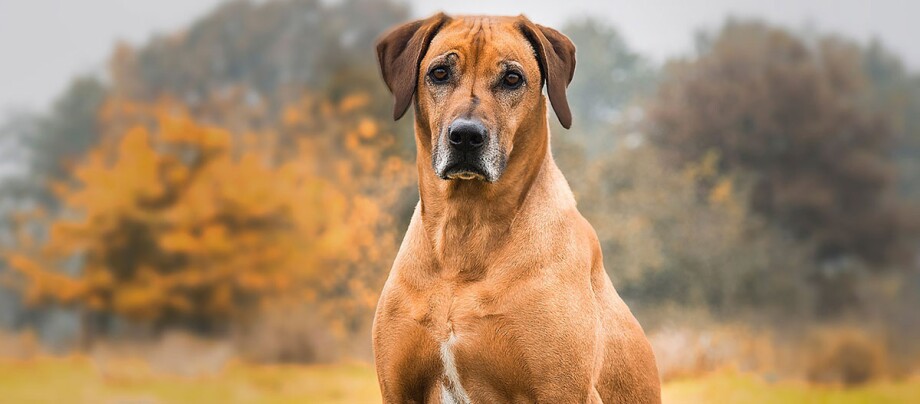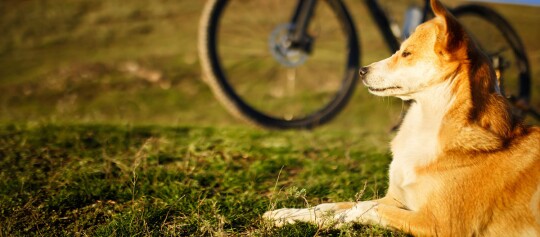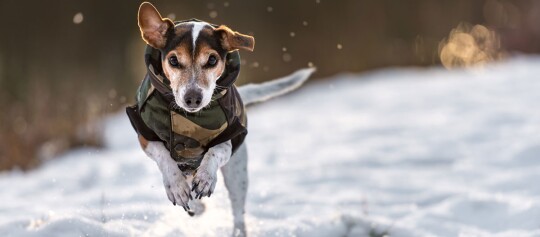Rhodesian Ridgeback – from lion hunter to sports companion
18.02.2024 - Reading time: 8 minutes

In the past it defended its owners’ property; today the Rhodesian Ridgeback is a popular breed with an athletic build and fantastic character. This imposing four-legged friend sporting a ridge along its back is a versatile breed that makes a great tracker, rescue dog or guard dog as well as a loyal family and companion dog.
- From the cradle of Africa
- Rhodesian Ridgeback character
- Rhodesian Ridgeback profile
- Is the Rhodesian Ridgeback suitable for first-time owners?
- How dangerous is a Rhodesian Ridgeback?
- Does a Rhodesian Ridgeback make a good family dog?
- How much does a Rhodesian Ridgeback cost?
- Buying a Rhodesian Ridgeback – what to consider
- Tips for looking after a Rhodesian Ridgeback
- Diet of a Rhodesian Ridgeback
From the cradle of Africa
The Rhodesian Ridgeback comes from the South African and Zimbabwean wilderness. It is descended from the local wild dogs there, which were bred together with English hunting dogs. The result was an impressive, muscular dog, which was originally used to guard farms and hunt big game and lions. The Rhodesian Ridgeback is known for its courage and self-confidence, along with its friendly, intelligent nature. These special dogs now have many fans, even far away from their homeland. The Rhodesian Ridgeback, which has been internationally recognised since 1926, is the only South African dog breed.
Rhodesian Ridgeback character
Dignified and intelligent – the Rhodesian Ridgeback in a nutshell. When hunting lions, the ability to make decisions and solve problems independently were essential skills for this hunting dog. This means that the Rhodesian Ridgeback has a mind of its own and is very assertive. Problems may arise if the Rhodesian Ridgeback is not trained in a way befitting its character.
However, if it accepts its owner as leader, it can be trained well using positive reinforcement. Once you have built a relationship between you and the animal, it will be loyal, devoted and faithful. The Rhodesian Ridgeback benefits from its ancestors’ ability to think quickly: it usually assesses unknown situations correctly and instinctively reacts in an appropriate way.
Incidentally, crossbreeds such as the Rhodesian Ridgeback-Labrador mix are also growing in popularity. It is important to remember that both of these breeds are hunting dogs, and their behaviour and needs reflect this. Even though Labrador Retrievers are known for being great family dogs, with crossbreeds it is impossible to predict which of the different breeds’ temperaments will ultimately dominate.
NewsletterRhodesian Ridgeback
Breed | Rhodesian Ridgeback |
Origin | South Africa (Zimbabwe, formally Rhodesia) |
Classification | Hounds, bloodhounds and related breeds |
Size | Males 63 to 69 cm at shoulder height – females 61 to 66 cm at shoulder height |
Weight | Males approx. 36.5 kilograms – females approx. 32 kilograms (according to the breed standard, though most dogs are significantly larger and heavier; males of 50 kg are not uncommon) |
Physique | powerful, muscular, athletic, deep-chested, relatively long neck |
Eyes | round and clear, should coordinate with coat colour |
Ears | large, high-set, floppy ears |
Coat and colour | short-haired, light or reddish wheat-coloured, sometimes with a dark “mask”, small white markings are permitted |
Special features | Strip of fur growing in opposite direction along the back (‘ridge’) |
Nature | friendly, intelligent, spirited, strong hunting instinct, reserved around strangers |
Care | daily brushing with rubber brush, sheds all year round |
Health | sometimes problems with the thyroid, such as hypothyroidism, congenital epilepsy, knee dysplasia, hip dysplasia, hereditary disease DS (Dermoid Sinus) |
We have the best products for your Rhodesian Ridgeback!
Is the Rhodesian Ridgeback suitable for first-time owners?
The Rhodesian Ridgeback is not a dog for first-time owners. If you decide that this is the breed for you, you should have experience in looking after dogs and be confident. You must also not overlook the Rhodesian Ridgeback’s hunting instinct, which is typical of the breed. To get this under control, the dog needs appropriate exercise and consistent, yet loving training, as the Rhodesian Ridgeback is also rather sensitive. If, despite your experience with dogs, you find yourself asking “How do I train my Rhodesian Ridgeback?”, it is always worthwhile seeking the advice of an experienced dog trainer. This means that you will have support and the reassurance of knowing that you are doing everything correctly from the beginning. The Rhodesian Ridgeback takes around three years to fully mature, which means that you need patience and staying power to train it well.
A Rhodesian Ridgeback is a spirited creature – as long as you provide it with plenty of variety and activities, you will have a relaxed, well-rounded dog. So, if you are a rider or cyclist, the Rhodesian Ridgeback has the stamina needed to make a great companion. Sports that build their endurance and speed are also very popular. The Rhodesian Ridgeback is not at all suited to life in a kennel: in addition to living with a family, ideally they should also have access to a garden. Their home needs to be spacious enough to accommodate this large dog. Caution is also advised if there are young children in the house. The dog’s size and strength alone means that they could hurt a child, even if just playing around. Do not leave your child unsupervised with this real powerhouse of a dog.
How dangerous is a Rhodesian Ridgeback?
The Rhodesian Ridgeback is not dangerous or aggressive by nature. However, due to its strength and size as well as its temperament, make no mistake, it is more powerful than a human and especially a child. Training their dog properly is therefore a duty of responsibility that any Rhodesian Ridgeback owner should take very seriously, because if it does not receive consistent training, has bad experiences with people or is not sufficiently well exercised, a Rhodesian Ridgeback can be potentially dangerous. However, this is true for most particularly large and powerful breeds. Even if you already have experience with dogs, attending dog training lessons – preferably with your Rhodesian Ridgeback puppy – is definitely recommended. Due to the dog’s impressive size and strength, many often wonder if the Ridgeback is a fighting dog. This is absolutely not the case. Furthermore, the Rhodesian Ridgeback is not officially classed as a dangerous dog in any German state. Studies have found that dogs of this breed do not display any notable degree of aggression.

Does a Rhodesian Ridgeback make a good family dog?
The Rhodesian Ridgeback is intelligent and sensitive. If it is raised from a puppy to be part of the family, it makes a loyal companion. In order for a Rhodesian Ridgeback to live happily as a family dog, it requires a caregiver who can patiently provide consistent training. You should always supervise a Rhodesian Ridgeback around your kids, even if it is well behaved. They can sometimes be boisterous, especially when still young or going through puberty. It is advisable to not let even older children or teenagers be solely responsible for the dog – on walks, for instance. This is because they are unlikely to have the physical strength to keep a dog of this size under control. The same applies to dogs of other large breeds.
How much does a Rhodesian Ridgeback cost?
It is not easy to give an average price for a Rhodesian Ridgeback – the price often fluctuates in line with a breed’s popularity. For a Rhodesian Ridgeback, you can currently expect to pay anything upwards of 1,500 euros. However, if you are looking to buy a Rhodesian Ridgeback puppy, the price should not be the most important consideration. Finding a responsible Rhodesian Ridgeback breeder is much more important. Besides breeders, you can sometimes find a Rhodesian Ridgeback in need via a rehoming centre or animal welfare organisation.
Buying a Rhodesian Ridgeback – what to consider
When looking for a Rhodesian Ridgeback breeder, make sure that they are reputable. A good breeder has nothing to hide and will, for example, be happy to introduce you to their animals in their home environment. If, on the other hand, a seller only wants to show you a single animal at an anonymous meeting place, such as a car park or a shed, you should be wary. You should also never buy your animals from illegal puppy dealers. Often, these animals have been kept in conditions that do not meet animal welfare requirements, are sick and sometimes die at a young age. Never buy an animal like this out of pity! This only serves to support the illegal animal trade.
A serious breeder, on the other hand, will have all the necessary papers such as vaccination records, and makes sure that the animals receive all required veterinary treatment (such as vaccinations and deworming) and that this is documented. They may ask you questions about your experience with this breed and your home environment. Do not be offended by questions like these; it is a good sign: a responsible breeder wants to make sure that their dogs will be in good hands. But you can also ask them any questions you have about the dogs and how they are bred. You should ask about the parents and their health. It goes without saying that you should be able to view the mother together with her pups.
Tips for looking after a Rhodesian Ridgeback
The Rhodesian Ridgeback’s short coat is very easy to care for; however, the animals shed all year round, so a daily brush to remove any loose hair is recommended. As the dog does not have much of an undercoat, make sure that it does not get too cold, especially in winter, when it will need to stay constantly on the move when outdoors. Clean the dog’s ears with a damp cloth now and again and regularly give it bones to gnaw on to help look after its teeth.
Diet of a Rhodesian Ridgeback
Large dog breeds have special requirement, especially when they are growing. To ensure that your Rhodesian Ridgeback grows up to be healthy, it is best to seek veterinary advice on what food is suitable for your dog. Your dog’s energy requirements are also determined by its age and activity levels. Senior dogs, for example, usually have a slower metabolism and therefore need less calorie-rich food. Changes in hormone levels after having your pet neutered can also affect energy requirements, meaning that a change in diet may be advisable. To ensure that your Rhodesian Ridgeback lives a long, healthy life, make sure that it receives appropriate veterinary care as well as being fed a good diet. This includes, for example, all recommended vaccinations and treatments for parasites as well as age-appropriate health check-ups. Of course, you should always also take them to the vet if you think that they might be ill. This allows illnesses to be detected and treated at an early stage.

